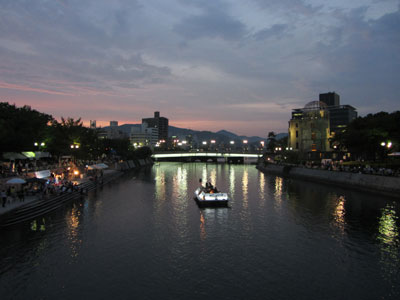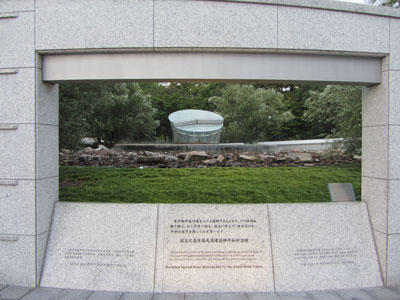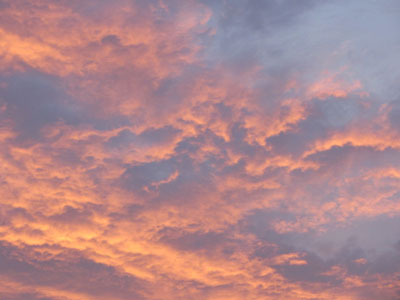Hiroshima Travelogue - Episode 11
We move out of the Chugoku daily; exactly called the Chugoku Shimbun daily. They say it circulates some 700,000 copies every day. It will publish an article about the meeting between members of [Iran’s] Peace Museum (us) and survivors of the atomic bombings of Hiroshima.
Here we go to the Peace Park. Everything seems to be ready to the upcoming ceremony. Erected in a corner of the park is a monument to the Hiroshima Bombing with a map of the building at its entrance and a structure at the end with a Japanese epigraph and a large clock showing 8:15; the exact time of the bombing on August 6th 1945. The clock is wet; water pours over the clock and forms a little pond about it as a memorial to those who perished out of thirst and injury. The debris garnered from the ruins of the bombing is placed about the pond.

The river beside the Peace Park; the picture shows the remnants of a dome structure which have survived the Hiroshima bombings.
We step in a steep path to reach the main building of the complex. The bomb hit the ground some 200 meters away north east of the complex. The building’s entrance is decorated with innumerable pictures of probably the event’s victims. We keep on our way down the steep path anti-clockwise to get to the main hall; to the day of the bombardment.

Entrance of the Monument
Here is a round structure with a 360 degree view. It is constructed with over 140,000 pieces to resemble those killed directly or indirectly in the bombing until the end of 1945. 12 pillars keep the structure up and are said to be the link between present and the past; or the alive and the dead. Right in the middle of the round structure is the time 8:15 inscribed on a stone watch covered with water current. The monument abounds with meaning despite simplicity.
We also pop in other spots of the Hiroshima memorial complex during our visit. Numerous screens are placed in a hall to give visitors information of any kind about the A-bomb attack in the city. Visitors are also allowed to access archives of memoirs belonging to the survivors and their pictures of the incident. All the data is available in Japanese, English, Chinese and Korean.
***

The sunset in Hiroshima
Accompanied with some of our group members who still could and would continue the visit, we went to the riverside as the sun was about to set. Music could be heard from the river bank. The players played it flawlessly. It is like it’s being played in memory of the August 6 victim. Here are individuals from the green and black continents not to mention the attending Japanese. A backpacking lad happens to realize that we are from Iran and comes closer. He says he is from Canada and calls US President Obama’s name several times. I don’t know what he is thinking but he smells of booze as I take a picture with him.
Hedayatollah Behboudi
Translated by: Abbas Hajihashemi
Number of Visits: 5042








The latest
- The Necessity of Standardizing Oral History and Criticism of General Mohsen Rezaei
- The 368th Night of Remembrance – Part 1
- Oral History News of Khordad 1404 (May 22nd – June 21st 2025)
- Najaf Headquarters Human Resources
- The Embankment Wounded Shoulders – 12
- Annotation
- The 367th Night of Memory– 5
- The Founder of Hosseiniyeh Ershad
Most visited
Operation Beit al-Moqaddas and Liberation of Khorramshahr
After Operation Fat’h al-Mobin, we traveled to Kermanshah and visited Sar-e-Pol-e-Zahab before heading to Ilam. During Operation Beit al-Moqaddas, the 27th Brigade was still receiving support from the West. We maintained contact with individuals who had previously worked in Area 7 and were now leading the brigade. It was through these connections that I learned about Operation Beit al-Moqaddas.Memoirs of Hujjat al-Islam Reza Motalebi
Hujjat al-Islam Reza Motalebi is a cleric from Isfahan. Before the revolution, he was the imam of the Fallah Mosque – which was later renamed Abuzar Mosque. By his presence and efforts, Abuzar Mosque soon became a base for supporters of the Imam and the revolution. After the victory of the revolution, he played a role in uniting forces and maintaining political vitality in southwest Tehran.The Necessity of Receiving Feedback in Oral History
Whenever we engage in a task, we naturally seek ways to evaluate our performance — to correct shortcomings and enhance strengths. Such refinement is only possible through the feedback we receive from others. Consider, for instance, a basketball player whose shots are consistently accurate; should he begin shooting blindfolded, his success rate would rapidly decline, as he would be deprived of essential feedback from each attempt.Sir Saeed
The book “Sir Saeed” is a documentary [narrative] of the life of martyr Seyyed Mohammad Saeed Jafari, written by Mohammad Mehdi Hemmati and published by Rahiyar Publications. In March 2024, this book was recognized as one of the selected documentary biographies in the 21st edition of the Sacred Defense Book of the Year Award. The following text is a review on the mentioned book.

